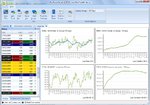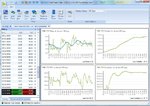You are using an out of date browser. It may not display this or other websites correctly.
You should upgrade or use an alternative browser.
You should upgrade or use an alternative browser.
Pairs Trading UK & US Stocks Journal
- Thread starter stocktrader77
- Start date
- Watchers 20
stocktrader77
Active member
- Messages
- 101
- Likes
- 5
Another thing that I have read is that we should select pairs that have similar betas. The difference between the betas should be less than 0.2. The difference between the betas of GLNG and ESEA is 0.57 according to MSN Money's site. The difference between the betas of WLL and HP is 0.56 but the difference between the betas of MWV and GEF is only 0.13. Does the difference in beta values matter? If not, why not (how can a pair be market neutral if the betas are significantly different)? Click on the link below to read about the beta issue:
Pairs Trading, Convergence Trading, Cointegration
Pairs Trading, Convergence Trading, Cointegration
stocktrader77
Active member
- Messages
- 101
- Likes
- 5
Is there an optimal look-back period for finding pairs? I have read that it is a good idea to test pairs over multiple time frames but I don't know if that matters.
Do you mean for correlation? I just use a simple 100 day lookback for correlation, seems to work fine for me.
stocktrader77
Active member
- Messages
- 101
- Likes
- 5
Another thing that I have read is that we should select pairs that have similar betas.
Yes some pair traders do this, however finding 2 stocks with high correlation and similar beta's are far and few between, you can position size based on beta, but I just prefer to stick with 2 highly correlated stocks in the same industry, keeping it simple is what I do.
Do you mean for correlation? I just use a simple 100 day lookback for correlation, seems to work fine for me.
How often should one look for new pairs? For example, I have many pairs set up in PairTrade Finder now. In six months time should I backtest again?
stocktrader77
Active member
- Messages
- 101
- Likes
- 5
How often should one look for new pairs? For example, I have many pairs set up in PairTrade Finder now. In six months time should I backtest again?
Yes I backtest my stock groups every couple of months and re-add pairs, there's no hard rule for this, you could probably keep the same pairs for years if the correlation holds up.
stocktrader77
Active member
- Messages
- 101
- Likes
- 5
Sold SMDR - 103.75
Covered DGO - 159.75
Covered DGO - 159.75
An excellent thread - thanks Stocktrader. This is something I've been thinking of trying but not yet had a crack at. The PDF is really useful. The examples imply that IG Index allows you to place non-integer stakes - is that the case ? eg: Long RDSA at £1.00 per point / short BP at £3.29 per point. I use Capital Spreads, who allow only stakes that are multiples of £1.
Last edited:
I've been exploring the guidelines offered in the PDF this afternoon and done some calculations of my own. Based on the last 22 days' data it seems that the DAX and the FTSE 100 are 96% correlated and are good candidates for pairs trading.
However, if the calculations are performed using EOD data the market is likely to have moved by the time you try to open new positions the next morning. So do you recalculate to seek confirmation that the trade is still viable ? Or does your program constantly monitor prices during the day and give signals to be acted on immediately ?
However, if the calculations are performed using EOD data the market is likely to have moved by the time you try to open new positions the next morning. So do you recalculate to seek confirmation that the trade is still viable ? Or does your program constantly monitor prices during the day and give signals to be acted on immediately ?
The default refresh for PairTrade Finder is set at 5 minutes by default. You have to keep the program running while the markets are open so that it can refresh the prices. You can adjust the time between automatic price refreshes. In the Preferences, you can set the program to produce a sound every time an entry or exit is generated for the stock pairs that you have saved.
Lado
Lado
Captain Haddock
Active member
- Messages
- 122
- Likes
- 5
An excellent thread - thanks Stocktrader. This is something I've been thinking of trying but not yet had a crack at. The PDF is really useful. The examples imply that IG Index allows you to place non-integer stakes - is that the case ? eg: Long RDSA at £1.00 per point / short BP at £3.29 per point. I use Capital Spreads, who allow only stakes that are multiples of £1.
Yes IG do allow stakes in multiples of pence.
Thanks Lado. The case for the program (rather than manual methods) is stacking up further. Does it work with indices and commodities or just equities ?
Stocks and ETF's. I haven't tried inputting index symbols. At the end of the day you would be pairing ETF's anyway wouldn't you?
I have only been using the program for two weeks so I am no expert. However, I have read about the other software approaches available but none appealed to me. There is room for improvement with PTF but, for the price, I think it is the best out there. Plus when you have very experienced investors such as the author of this thread (I hope he doesn't think we are hijacking his journal!) using PTF, that is a strong endorsement in my opinion.
Lado
stocktrader77
Active member
- Messages
- 101
- Likes
- 5
JGH, yes you can either load the cash indices or ETFs as lado suggests, you can trade the emini's with the indices signals but I wouldn't even bother, theres heaps of really good stock pairs out there. No your not hijacking the thread lado, I want this journal to be a place to share and learn for all of us, just because Im a experienced trader doesn't mean I can't learn anything from someone just starting out, a lot of my ideas have been induced by someone else's thoughts and opinions, so they are always welcome.
Placed 1 trade on Monday in the US residental property industry
Long Entry EQR - 18.47
Short Entry ESS - 53.16
Placed 1 trade on Monday in the US residental property industry
Long Entry EQR - 18.47
Short Entry ESS - 53.16
Attachments
Thanks Lado and Stocktrader. I was envisaging spreadbetting indices such as DAX / FTSE100 (or, strictly, their cash futures) rather than trading ETFs that are based on them - unless you recommend otherwise. I'm also looking at pairs such as gold / silver, which are very much out of kilter at present - again, ideally spreadbetting rather than using ETFs.
I guess if the software doesn't look at commodities then one could use certain ETFs as a very good proxy for them.
I guess if the software doesn't look at commodities then one could use certain ETFs as a very good proxy for them.
Last edited:
the blades
Experienced member
- Messages
- 1,336
- Likes
- 275
Thanks Lado and Stocktrader. I was envisaging spreadbetting indices such as DAX / FTSE100 (or, strictly, their cash futures) rather than trading ETFs that are based on them - unless you recommend otherwise. I'm also looking at pairs such as gold / silver, which are very much out of kilter at present - again, ideally spreadbetting rather than using ETFs.
I guess if the software doesn't look at commodities then one could use certain ETFs as a very good proxy for them.
interesting idea, but if you think that a universe of about 12,000 stocks is providing only a few opportunities a day, there may be little chance that a few indices / commodities through up any opportunities. Worth a look though....
UTB
Similar threads
- Replies
- 0
- Views
- 3K


